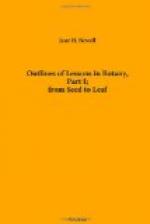PREFACE.
In this study, as in all scientific teaching, the teacher’s aim should be to foster in his pupils the power of careful observation and clear expression. The actual amount of knowledge gained at school must needs be small, and often quickly forgotten, but the habit of right study is an invaluable possession.
The former method of teaching Botany was confined almost wholly to dry, technical classification. The pupil learned to find the name and order of a plant, but its structure, its habits, its life in short, were untouched by him. We know now that Nature is the best text-book. The pupil should first ask his questions of her and try to interpret her answers; then he may learn with profit what those who better understand her speech have to tell him.
This method of teaching, however, requires much, very much, of the teacher. He must be himself intelligent, well trained, and able to give time to the preparation of his lessons. It seems to us, who are but amateurs, as if it were impossible to teach thus without a thorough comprehension of the whole field. Our own ignorance oppresses us so much that we feel tempted to say that we cannot attempt it. But if the work of leading children to observe the wonders about them is to be done at all, it must be done by us, who are not masters of our subject, and we must find out for ourselves how we can best accomplish this result, since we have so little to guide us.
It is with the hope that the experience of one who has tried to do this with some fair amount of success may be of use to other puzzled experimenters, that I venture to write out some outlines of lessons in Botany for beginners.
The method of beginning with the simpler forms of life is one that appeals to the scientific tendencies of the day. It seems logical to begin with lower forms and work up to the higher. But this method is only suitable for mature minds. We do not teach a child English by showing him the sources of the language; he learns it by daily use. So also the beginning of the study of any Natural Science by the young should be the observation of the most obvious things about them, the things which they can see, and handle, and experiment upon naturally, without artificial aids. Therefore this book concerns itself only with the Flowering Plants.
The author believes that the simplest botanical study should afford the means of identifying plants, as a large part of the student’s pleasure in the science will be the recognition of the things about him. The present volume affords the basis for future classification, which Part II, on flowers, will develop. It is, doubtless, as good a way, perhaps the best, to begin with a single plant, and study root, stem, leaves, and flowers as belonging to a whole, but the problem is complicated by practical difficulties. In our climate there are but two months of the school year when flowers are easily obtained. On the other hand, the material for these lessons can be got throughout the winter, and the class, well trained in methodical work, will begin the study of flowers at the season when every day brings some fresh wonder of beauty.




